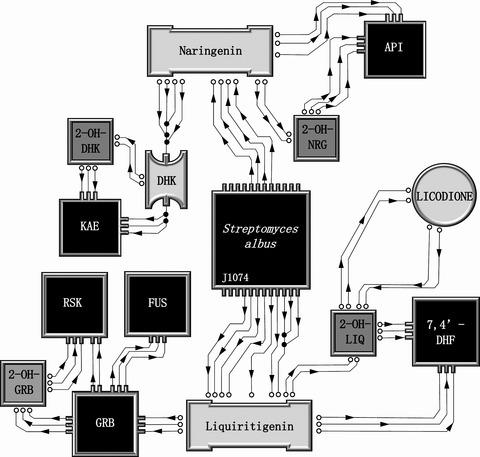当前位置:
X-MOL 学术
›
Microb. Biotechnol.
›
论文详情
Our official English website, www.x-mol.net, welcomes your feedback! (Note: you will need to create a separate account there.)
De novo biosynthesis of garbanzol and fustin in Streptomyces albus based on a potential flavanone 3-hydroxylase with 2-hydroxylase side activity
Microbial Biotechnology ( IF 4.8 ) Pub Date : 2021-07-03 , DOI: 10.1111/1751-7915.13874 Laura Marín 1, 2, 3 , Ignacio Gutiérrez-Del-Río 1, 2, 3 , Claudio Jesús Villar 1, 2, 3 , Felipe Lombó 1, 2, 3
Microbial Biotechnology ( IF 4.8 ) Pub Date : 2021-07-03 , DOI: 10.1111/1751-7915.13874 Laura Marín 1, 2, 3 , Ignacio Gutiérrez-Del-Río 1, 2, 3 , Claudio Jesús Villar 1, 2, 3 , Felipe Lombó 1, 2, 3
Affiliation

|
Flavonoids are important plant secondary metabolites, which were shown to have antioxidant, anti-inflammatory or antiviral activities. Heterologous production of flavonoids in engineered microbial cell factories is an interesting alternative to their purification from plant material representing the natural source. The use of engineered bacteria allows to produce specific compounds, independent of soil, climatic or other plant-associated production parameters. The initial objective of this study was to achieve an engineered production of two interesting flavanonols, garbanzol and fustin, using Streptomyces albus as the production host. Unexpectedly, the engineered strain produced several flavones and flavonols in the absence of the additional expression of a flavone synthase (FNS) or flavonol synthase (FLS) gene. It turned out that the heterologous flavanone 3-hydroxylase (F3H) has a 2-hydroxylase side activity, which explains the observed production of 7,4′-dihydroxyflavone, resokaempferol, kaempferol and apigenin, as well as the biosynthesis of the extremely rare 2-hydroxylated intermediates 2-hydroxyliquiritigenin, 2-hydroxynaringenin and probably licodione. Other related metabolites, such as quercetin, dihydroquercetin and eriodictyol, have also been detected in culture extracts of this recombinant strain. Hence, the enzymatic versatility of S. albus can be conveniently exploited for the heterologous production of a large diversity of plant metabolites of the flavonoid family.
中文翻译:

基于潜在的具有 2-羟化酶副活性的黄烷酮 3-羟化酶在白色链霉菌中从头生物合成 garbanzol 和 fustin
类黄酮是重要的植物次生代谢产物,已被证明具有抗氧化、抗炎或抗病毒活性。在工程微生物细胞工厂中异源生产黄酮类化合物是从代表天然来源的植物材料中纯化黄酮类化合物的一种有趣的替代方法。工程细菌的使用允许生产特定的化合物,而不受土壤、气候或其他植物相关生产参数的影响。本研究的最初目标是使用Streptomyces albus实现两种有趣的黄烷醇、garbanzol 和 fustin 的工程化生产。作为生产主机。出乎意料的是,在没有黄酮合酶 (FNS) 或黄酮醇合酶 (FLS) 基因的额外表达的情况下,工程菌株产生了几种黄酮和黄酮醇。结果表明,异源黄烷酮 3-羟化酶 (F3H) 具有 2-羟化酶副活性,这解释了观察到的 7,4'-二羟基黄酮、resokaempferol、山奈酚和芹菜素的产生,以及极其罕见的 2 的生物合成-羟基化中间体 2-羟基甘草素、2-羟基柚皮素,可能还有甘草酮。在该重组菌株的培养物提取物中也检测到了其他相关代谢物,例如槲皮素、二氢槲皮素和圣草酚。因此,S. albus的酶学多功能性 可方便地用于异源生产多种类黄酮家族的植物代谢物。
更新日期:2021-07-03
中文翻译:

基于潜在的具有 2-羟化酶副活性的黄烷酮 3-羟化酶在白色链霉菌中从头生物合成 garbanzol 和 fustin
类黄酮是重要的植物次生代谢产物,已被证明具有抗氧化、抗炎或抗病毒活性。在工程微生物细胞工厂中异源生产黄酮类化合物是从代表天然来源的植物材料中纯化黄酮类化合物的一种有趣的替代方法。工程细菌的使用允许生产特定的化合物,而不受土壤、气候或其他植物相关生产参数的影响。本研究的最初目标是使用Streptomyces albus实现两种有趣的黄烷醇、garbanzol 和 fustin 的工程化生产。作为生产主机。出乎意料的是,在没有黄酮合酶 (FNS) 或黄酮醇合酶 (FLS) 基因的额外表达的情况下,工程菌株产生了几种黄酮和黄酮醇。结果表明,异源黄烷酮 3-羟化酶 (F3H) 具有 2-羟化酶副活性,这解释了观察到的 7,4'-二羟基黄酮、resokaempferol、山奈酚和芹菜素的产生,以及极其罕见的 2 的生物合成-羟基化中间体 2-羟基甘草素、2-羟基柚皮素,可能还有甘草酮。在该重组菌株的培养物提取物中也检测到了其他相关代谢物,例如槲皮素、二氢槲皮素和圣草酚。因此,S. albus的酶学多功能性 可方便地用于异源生产多种类黄酮家族的植物代谢物。








































 京公网安备 11010802027423号
京公网安备 11010802027423号